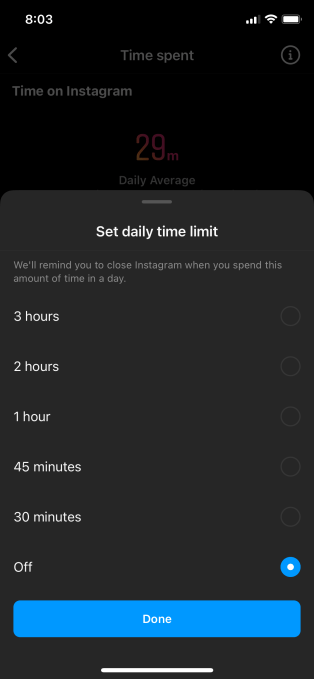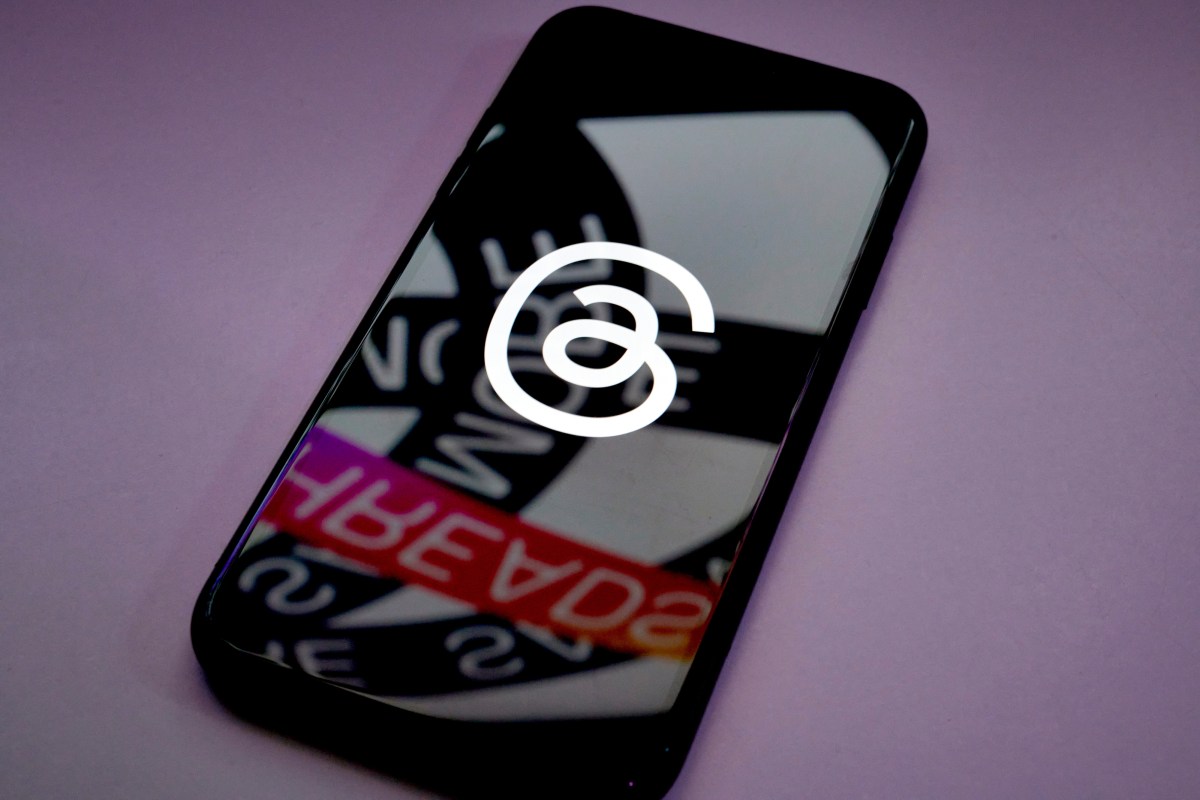Instagram quietly limits ‘daily time limit’ option – TechCrunch
RIP Mark Zuckerberg’s “time well spent“? In a move that appears to coincide with Facebook/Meta reporting slowing growth, photo-sharing app Instagram appears to have quietly removed the ability for mobile users to set a lower daily time limit reminder than 30 minutes.
Indeed, the app’s UX design nudges people to choose a three hour ‘limit’ (see screengrab below).
This daily time limit setting pops up a notification to the user once their app activity hits their preferred limit, reminding them to be conscious of how much time they are spending on the app — and maybe making it easier for them to choose to quit out of the app voluntarily.

Instagram’s daily time limit setting puts “3 hours” in the top slot — burying lower available limits (Screengrab: TechCrunch)
Previously the company supported a user-defined limit for Instagram that could be as low as 15 minutes — or even 10 minutes — per day, when it was making a big PR push to suggest that more ‘mindful’ usage of its services was possible, as concern over social media addiction surged.
But it seems the attention-loving adtech giant now wants Instagram users to spend longer eyeballing content feeds on the photo- and video-sharing platform where it can cash in by targeting them with ads. Which could be a result of pressure from the business side to eke out growth…
In its earnings earlier this month, Meta reported flat quarter-over-quarter usage for its eponymous app (Facebook) — and near flat growth for its other apps, which it wraps into a “family of apps” moniker, rather than breaking out Instagram, WhatsApp etc usage individually. (Daily active users of this ‘other apps’ category rose from 2.81BN in Q3 to 2.82BN in Q4; while monthly active users rose from 3.58BN in Q3 to 23.59BN in Q4; but usage of Facebook itself stayed entirely flat, quarter-over-quarter, at 1.93BN DAUs and 2.91BN MAUs.)
The disappointing Q4 results wiped 20% off the company’s value when they hit — which could be one reason why Meta’s growth teams may be seeing what levers they can tweak to drive engagement from existing users.
TechCrunch was alerted to the Instagram settings change by an tipster who shared screenshots of their account (see pics below) which show the company nudging them to “set a new value for your daily limit” — because, as it puts it, “the available daily limits are changing as part of an app update”. (Full marks to Meta for penning a sentence that fails to contain any meaningful explanation of why it’s making arbitrary changes to limit users’ control.)
This user had previously specified a 10 minute daily limit. However they’re now suddenly being informed this option is no longer available — and, presumably, any users who had not yet specified a daily limit or had picked a different (higher) limit would be unlikely to even realize that the 10 minute option had been deprecated.
And while Instagram’s notification to the user of this change to daily limits does state that they can retain their current 10 minute limit, the app uses blatant dark patterns to nag them into changing it — including by popping up a notification right above the 10 minute limit that’s indicated on their “time on Instagram” settings page, which further instructs: “This value is no longer supported. Please edit” — all of which is clearly designed to make them think they do actually have to switch to a higher limit.
“My choice has gone away, and if I try and change it, my old minimum of 10 minutes triples to 30 minutes as the new minimum,” the tipster told TechCrunch.
The source, who preferred to remain anonymous, likened this silent switch to “a tobacco company saying you can limit your packs a day, as it takes away smaller packs”.
“They don’t force the change but if go into the edit screen as it tells you to, then you have to force quit the app to get out without changing it,” they added.
We’ve recently seen Facebook/Meta using a similarly manipulative persistent notification tactic when trying to push a policy update on WhatsApp users in the face of a major T&Cs backlash — which has led to an (ongoing) consumer protection probe in the EU. But the company has a long, ignoble history of this sort of stuff. So none of this is surprising. But ofc that doesn’t make it okay.
It’s getting harder for companies like Meta to pull the wool, though. Oversight bodies are wising up to dark patterns. See for example — again in European Union — lawmakers in the parliament who recently overwhelmingly backed putting explicit restrictions on such manipulative tactics into upcoming rules set to apply widely to digital platforms.
So the scope for platforms to profit off of cynically self-serving defaults (or “available” settings) looks to be shrinking.
Our tipster wasn’t sure exactly when the 10 minute option they had been able to select previously was discontinued — but they told us the app had been “nagging for a couple of weeks” to press them to “edit” the setting.
We also checked what we could see ourselves to confirm this change applied more widely than to a single Instagram user — and found that 30 minutes seems to be the new ‘norm’ for app users.
A US-based TechCrunch reporter found the app also only offers them 30 minutes as the lowest available daily limit.
As with the tipster, the top option this user was presented with in the list of available times — and thus the option they’re most likely to notice, from a UX design point of view — was “3 hours” (aka 6x 30 minutes).
Another UK-based TCer who checked their app could also only select 30 minutes as the lowest daily limit for the notification on their Instagram.
Interestingly, the picture looked different on the Facebook mobile app. There the options offered to a TechCrunch reporter based in France technically included “0 hours, 0 minutes” — although that did not work when selected. However they were able to select a 5 minute limit (rising in 5 minute increments thereafter) so it looks as if the 30 minute minimum may not have been applied to the Facebook mobile app by Meta (yet).
We were also able to confirm that another UK-based Facebook mobile app user could select a 5 minute minimum on that app.
We asked Meta to confirm any changes it has made to the Instagram daily limits setting — as well as putting a number of other related questions to it — but at the time of writing the company had not responded.
Facebook garnered a lot of press back in 2018 when, with concern surging over the impact of social media platforms on teenagers’ mental health — it announced it was giving Instagram and Facebook users new “time management tools” — which included the ability to set a (soft) daily time on usage.
Users would also be able to view a daily average of time spent on the mobile app, based on a week’s usage.
“We want the time people spend on Instagram and Facebook to be intentional, positive and inspiring,” Ameet Ranadive, product management director at Instagram and David Ginsberg, director of research at Facebook, wrote as they introduced the bundle of time management features.
“Our hope is that these tools give people more control over the time they spend on our platforms and also foster conversations between parents and teens about the online habits that are right for them.”
The feature launch was linked to a wider company push — starting around 2017 — when it appeared to engage publicly with concerns about the negative impacts of social media. However Facebook did so by seeking to reframe the narrative by suggesting any problems with usage are incremental and manageable (i.e. rather than existential for its attention-dependent business) — just so long as the user has “tools” to support what it dubbed “meaningful social interactions”.
Hence the flotilla of tweaks and “controls” Facebook/Meta went on to announce — offering self-serving ‘fixes’ to address concerns about social media with the aim of preventing users actually stopping the habit entirely.
Of course these controls rarely — if ever — actually put users in control.
Moreover the underlying content ranking algorithms actively undermine user autonomy by optimizing for profit-maximizing ‘engagement’ — as Facebook whistleblower, Frances Haugen, went on to detail in hours of detailed testimony to lawmakers last year.
The Instagram daily time limit feature, for example, was a lot more mindfulness theatre than meaningful control right from the get go — since users just got a notification if/when they reached their desired daily time, rather than the app taking firmer action like actually locking them out until the next day.
As Haugen has testified, Facebook has demonstrated a systematic unwillingness to give up little slivers of profitability in service of a greater good (aka the welfare of its users/society) — up to and including, it now seems, letting Instagram users select a 10 minute soft limit on their usage. Which would allow for fewer ads to be served vs a 30 minute minimum — which means less profit for Meta…
So the company’s claim of trying to deliver ‘time well spent’ on its platforms looks to have past its sell by date: Another hollow publicity stunt to buy Fb time while its growth teams drum up new UX hacks to keep the eyeballs busy.
(On the flip side, it’s interesting to consider the recent popularity of viral word game, Wordle, whose creator suggested it should only be played for three minutes a day when he spoke to the BBC last month — while the app itself hard-limits the game to one puzzle per day.)
In any case, the debate about regulating powerful tech platforms has moved on considerably since 2017 — with tech giants like Meta now facing the prospect of hard limits on how they can operate, via incoming regulation such as the EU’s Digital Markets Act. Or the UK’s Age Appropriate Design Code which seeks to safeguard the welfare of children by enforcing strict privacy defaults and standards, and imposing other restrictions such as time limits on when platforms can message child users.
So if the secret of your ad-platform’s growth is dark pattern design and manipulative messaging — not to mention anti-competitive surveillance — then your investors do, certainly, have reasons for concern.



